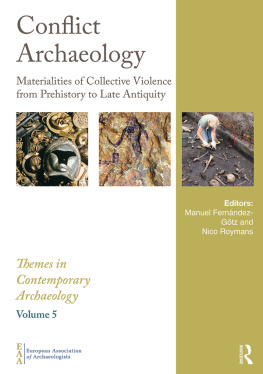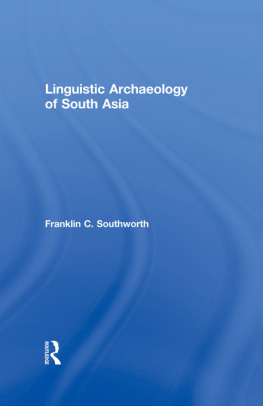First published 2018
by Routledge
2 Park Square, Milton Park, Abingdon, Oxon OX14 4RN
and by Routledge
711 Third Avenue, New York, NY 10017
Routledge is an imprint of the Taylor & Francis Group, an informa business
European Association of Archaeologists 2018
The right of Manuel Fernndez-Gtz and Nico Roymans to be identified as the authors of the editorial material, and of the authors for their individual chapters, has been asserted in accordance with sections 77 and 78 of the Copyright, Designs and Patents Act 1988.
All rights reserved. No part of this book may be reprinted or reproduced or utilised in any form or by any electronic, mechanical, or other means, now known or hereafter invented, including photocopying and recording, or in any information storage or retrieval system, without permission in writing from the publishers.
Trademark notice: Product or corporate names may be trademarks or registered trademarks, and are used only for identification and explanation without intent to infringe.
British Library Cataloguing-in-Publication Data
A catalogue record for this book is available from the British Library
Library of Congress Cataloging-in-Publication Data
Names: Fernndez-Gtz, Manuel. | Roymans, Nico. |
European Association of Archaeologists.
Title: Conflict archaeology : materialities of collective violence /
[edited by] Manuel Fernndez-Gtz and Nico Roymans.
Description: Abingdon, Oxon ; New York, NY : Routledge, 2018. |
Series: Themes in contemporary archaeology | Based on selected
sessions from the well-regarded annual conference of the European
Association of Archaeologists. | Includes bibliographical references
and index.
Identifiers: LCCN 2017029208 (print) | LCCN 2017032951 (ebook) |
ISBN 9781315144771 (Master) | ISBN 9781351384667 (Web PDF)
| ISBN 9781351384650 ( ePub) | ISBN 9781351384643 (Mobi/
Kindle) | ISBN 9781138502116 (hardback : alk. paper) |
ISBN 9781315144771 (ebk)
Subjects: LCSH: Military archaeologyCongresses.
Classification: LCC CC77.M55 (ebook) | LCC CC77.M55 C65 2018
(print) | DDC 355.009/01dc23
LC record available at https://lccn.loc.gov/2017029208
ISBN: 978-1-138-50211-6 (hbk)
ISBN: 978-1-315-14477-1 (ebk)
Typeset in Adobe Caslon Pro
by Apex CoVantage, LLC

The idea of producing this edited volume proceeds from a common interest in the study of mass violence and the archaeology of Romes imperial expansion in Gaul and Iberia. It is our explicit aim to place this research into the broader and expanding field of conflict archaeology. In 2015 we organised two symposia at respectively Amsterdam ( The Materiality of Conflict. Aims, methods and theory of conflict archaeology from Prehistory to modern times ) and the EAA Conference at Glasgow ( Battlefield archaeology: Exploring the materialities of conflict ), after which the decision was taken to collect a number of papers and edit a peer-reviewed volume out of them. Since most overview volumes on conflict archaeology are focused on rather recent historical periods, the choice was taken to focus on contributions dealing with Late Prehistory and the Roman period. For this purpose, we invited speakers from the sessions in Amsterdam and Glasgow, and in addition to that some other scholars were asked to contribute in order to further strengthen the profile and cohesion of the volume.
The nineteen chapters in this volume provide a combination of site-specific analysis and larger overviews, as well as a mixture of information coming from the reassessment of well-known sites (e.g. Alesia, Numantia , Thorsberger Moor) and new excavation and survey projects such as those at the Tollense Valley, Baecula, Arausio and Monte Bernorio. Beyond the discussion of particular case studies, we aim to contribute to the development of methodological and theoretical approaches to the study of past conflict. Although the volume is focused on ancient Europe, many of the contributions can be of interest for scholars working on other parts of the world and later periods. We hope that the book will play a role in the broader international discussion on conflict archaeology and be a stimulus for further research.
Finally, we would like to thank the EAA and in particular the series editors Prof. Kristian Kristiansen and Prof. Eszter Bnffy for including this volume into its new monograph series, as well as the two anonymous reviewers for their valuable comments.









